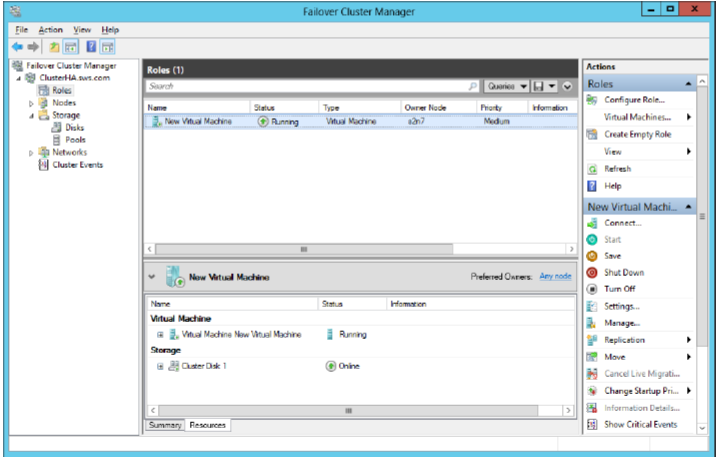Configuring HA Storage for Live Migration on Windows Server 2012
- April 29, 2014
- 12 min read
INTRODUCTION
Here is a reference network diagram of the configuration described in this guide.
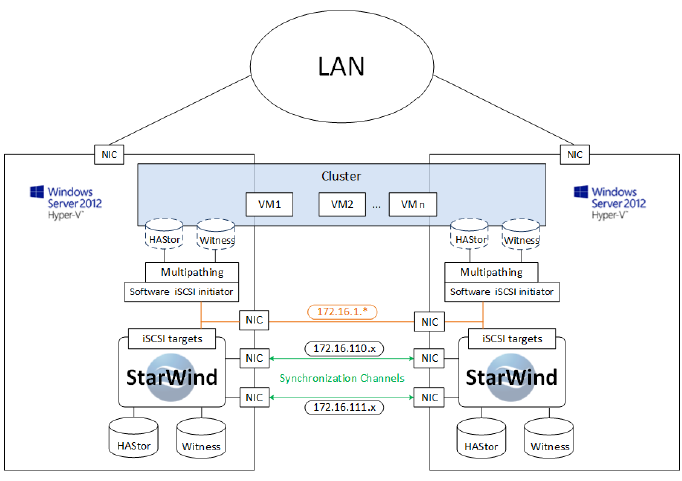
CREATING AN HA DEVICE
1. Open a StarWind configuration file.
Note: The default path is C:\Program Files\StarWind Software\StarWind\StarWind.cfg
2. Find the string “<!–<iScsiDiscoveryListInterfaces value=”1″/> –>” and uncomment it (should look as follows: <iScsiDiscoveryListInterfaces value=”1″/>).
3. Restart StarWind Service and repeat the same procedure on another StarWind HA node.
4. Launch StarWind Management Console: Start -> All Programs -> StarWind Software -> StarWind.
Note: The StarWind Console icon appears in the system tray when the Console is running. To open StarWind Management Console, double-click the icon or right-click it, and then select Start Management Console from the shortcut menu.
5. Select the server you want to provide with the iSCSI target device from the Console tree. Double-click the host to connect.
Note: If you are prompted to enter login and password, specify “root” and “starwind”, respectively. These are the default login and password, but you can always change them later.
6. After connecting to StarWind Service, you can create devices and targets on the server. Open Add Device Wizard by one of the following ways:
- Select Add Device from the Target menu.
- Select Add Device from the Devices shortcut menu (right-click to open it).
7. Add Device Wizard appears. Please, follow the wizard’s steps to create a new HA device.
8. Select the High Availability Device option button.
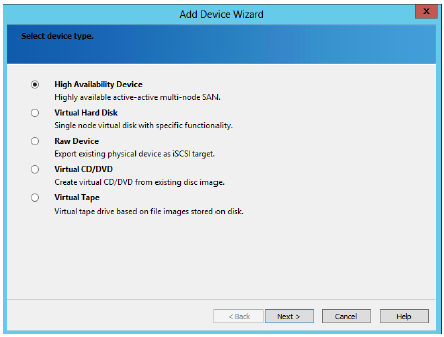
9. Click Next to continue.
10. Click Add to add a new host.
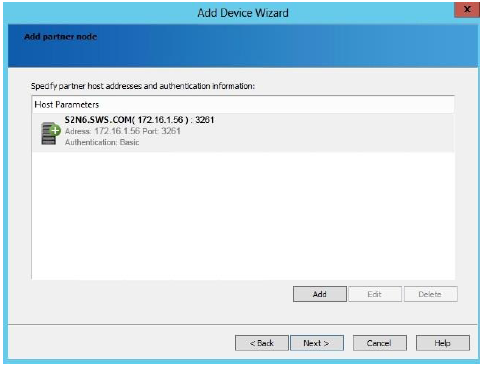
11. Specify partner server parameters. Enter the server IP-address in the Host text field. If needed, specify username and password for StarWind Service in the corresponding text fields.
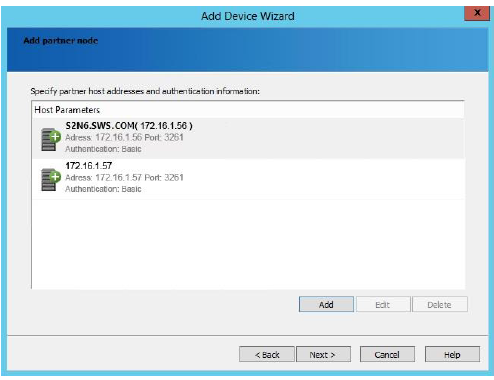
12. Click Next to continue.
13. Specify the appropriate information in the Target Alias and Target Name text fields.
Note: The name must be unique. Under this name the device is declared to iSCSI initiators that are connected to StarWind Service over an IP network.
14. Click to specify a name and location of an HA virtual disk on the server. If you want to create a new virtual disk, select the Create New checkbox.
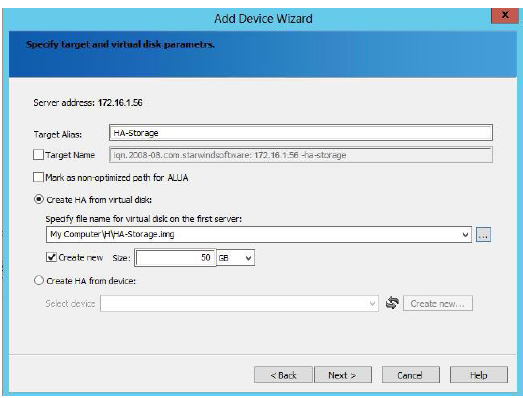
15. Click Next to continue.
16. Specify target and virtual disk parameters of the second node.
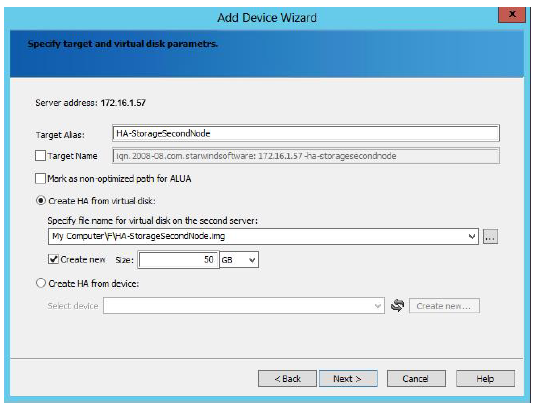
17. Click Next to continue.
18. Configure data synchronization and Heartbeat channel parameters.
Note: At least one Heartbeat channel must be separated from a synchronization channel due to the availability considerations.
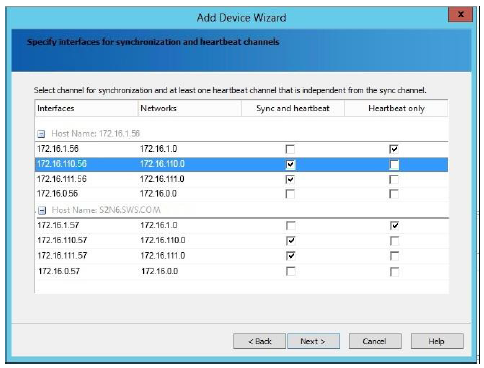
19. Click Next to continue.
20. Specify cache parameters of the HA device.

21. Click Next to continue.
22. Select an initialization method of the HA device.
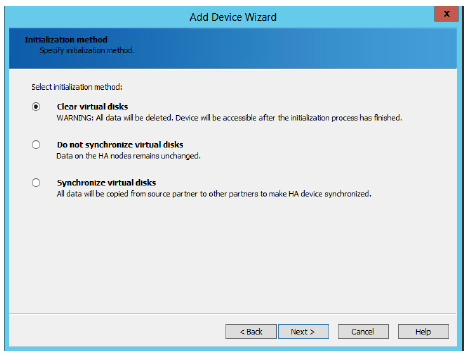
23. Check whether device parameters are correct. Click Back to make any changes. Click Next to continue.
24. Click Finish to close the wizard.
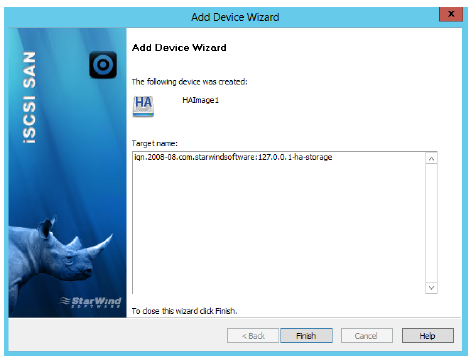
25. Click Finish to close the wizard.
Follow the similar procedure for creation of the second HA device that will be used as a witness disk.
CONFIGURING HYPER-V SERVERS
This document assumes that you have already configured Active Directory and two servers on the domain. It also assumes that you have enabled the Failover Clustering, Multipath I/O features, and the Hyper-V role on the both servers. These configurations can be performed using Server Manager (the Add Roles and Features option).
1. Launch Server Manager, select the Manage item, and click the Add Roles and Features option. Install the Hyper-V role, Multipath I/O, and Failover Clustering features following the wizard’s steps.
Note: Restart the server after the installation is completed.
2. Select Role-based or feature-based installation as an installation type and click Next to continue.
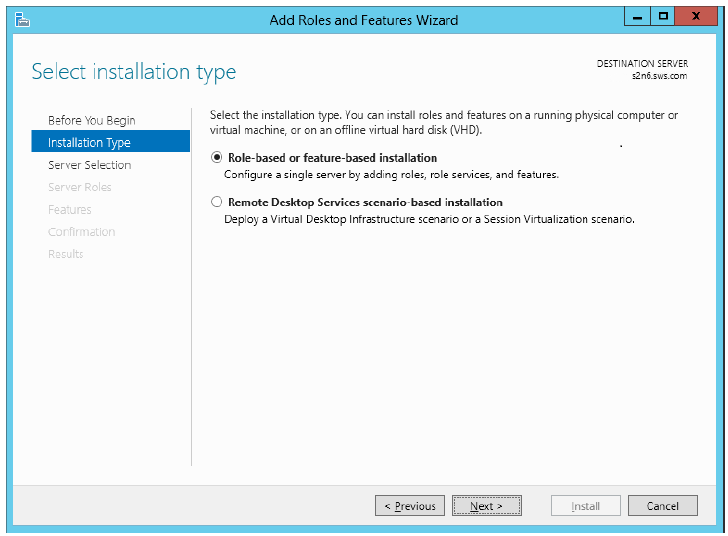
3. Select a server from the server pool. Use a filter to find an appropriate server.
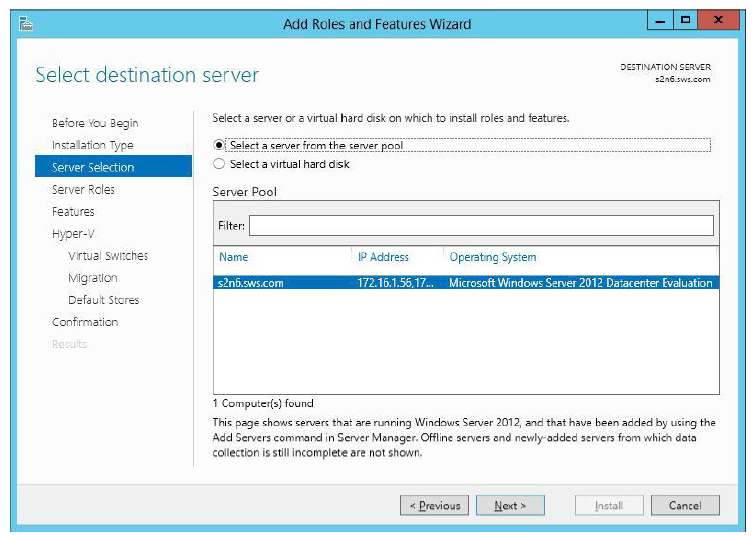
4. Click Next to continue.
5. Select the Hyper-V checkbox in the Roles section.
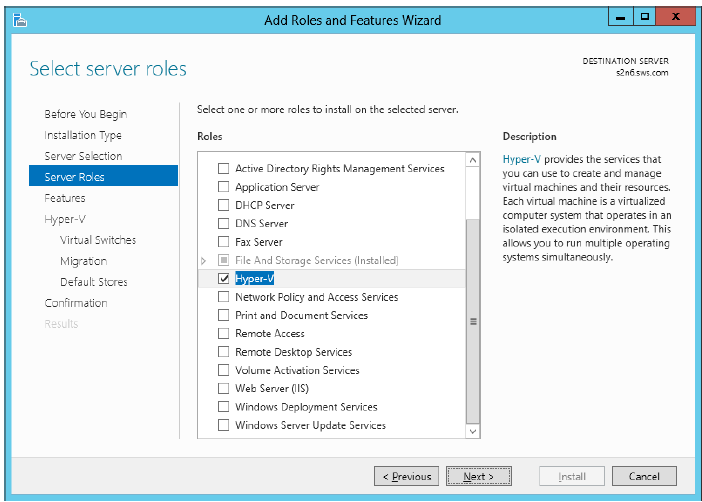
6. Click Next to continue.
7. Select Failover Clustering and Multipath I/O checkboxes in the Features section.
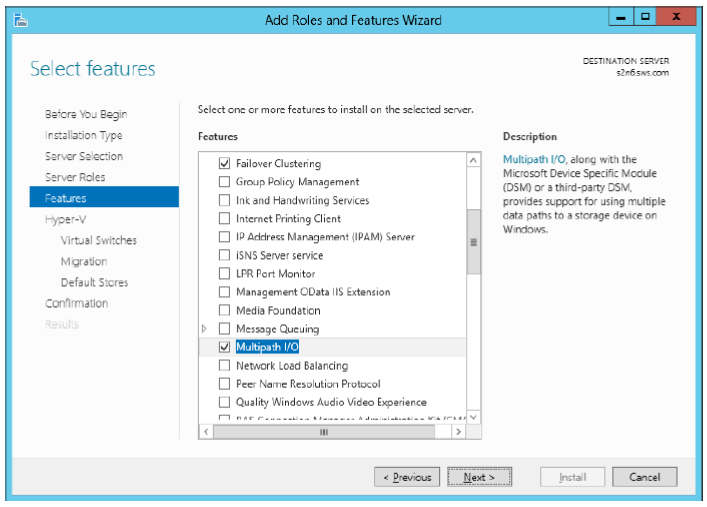
8. Click Next to continue.
9. Select network adapters for virtual switches in the Virtual Switches section.
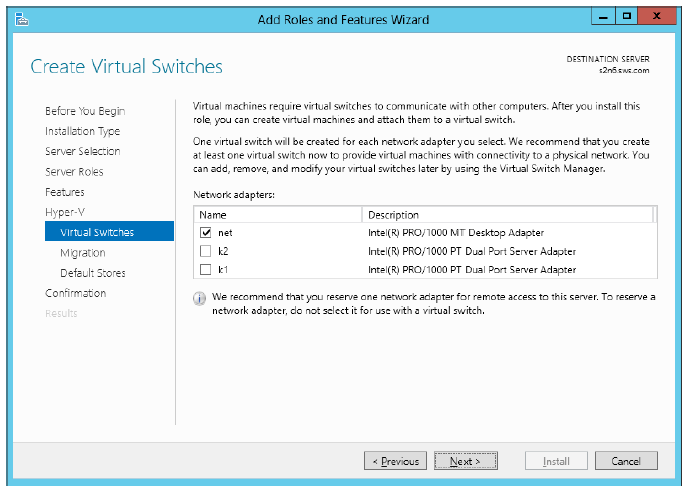
10. Click Next to continue.
11. Specify the settings of VM live migration in the Migration section.
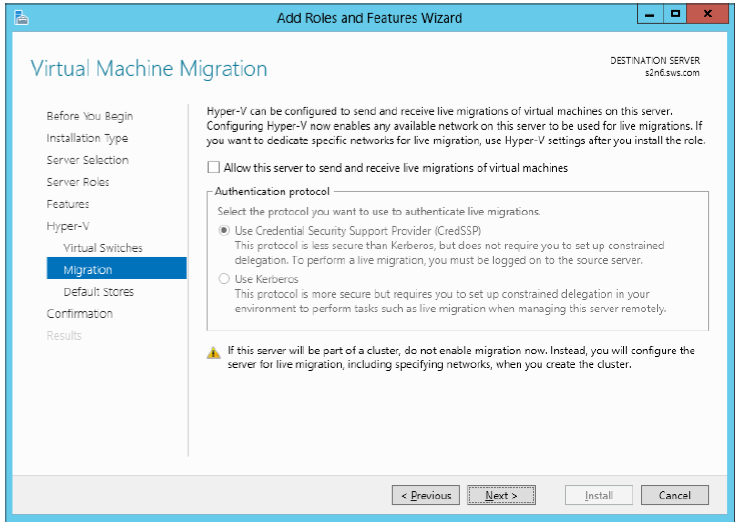
12. Click Next to continue.
13. Define location for virtual hard disk files in the Default Stores section.
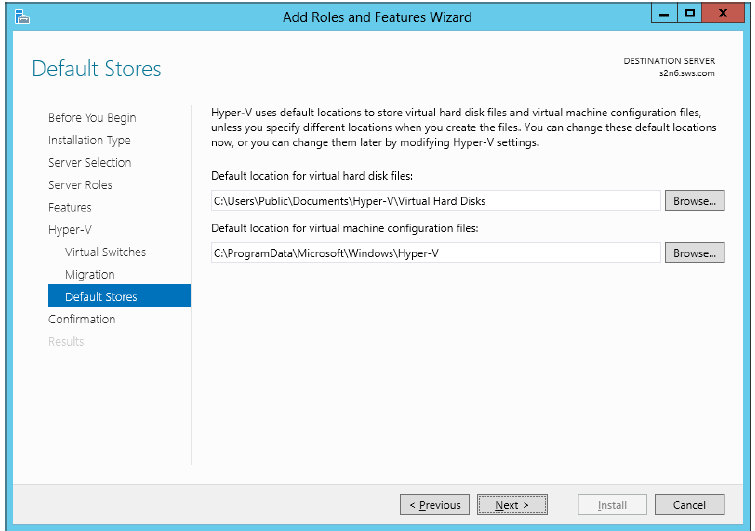
14. Click Next to continue.
15. Select the corresponding checkbox if you want the server to be restarted automatically, and click Install. Otherwise, click Install and restart server manually after the installation is completed.
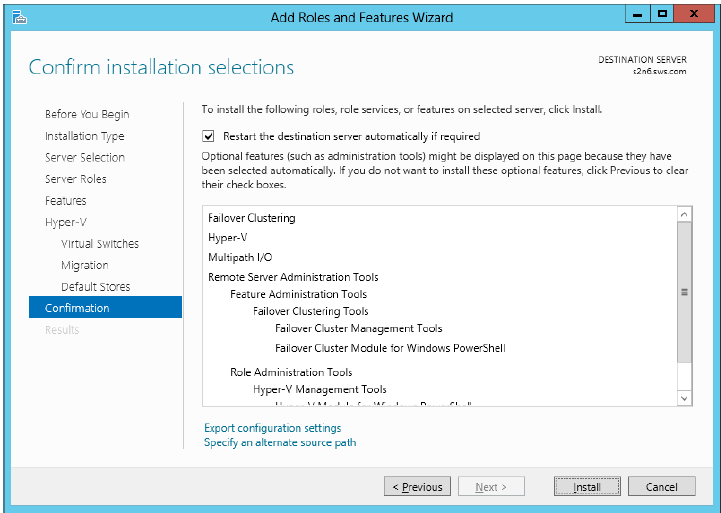
CONNECTING TARGETS
To connect the previously created disks on all servers that will be added to the cluster:
1. Launch Microsoft iSCSI Initiator: Start > Administrative Tools > iSCSI Initiator. The iSCSI Initiator Properties window appears.
2. Navigate to the Discovery tab.
3. Click the Discover Portal button. Enter an IP address of each StarWind Server in the appropriate field of the Discover Target Portal dialog. Select Microsoft ISCSI Initiator as your Local adapter and select your Initiator IP. Click OK.
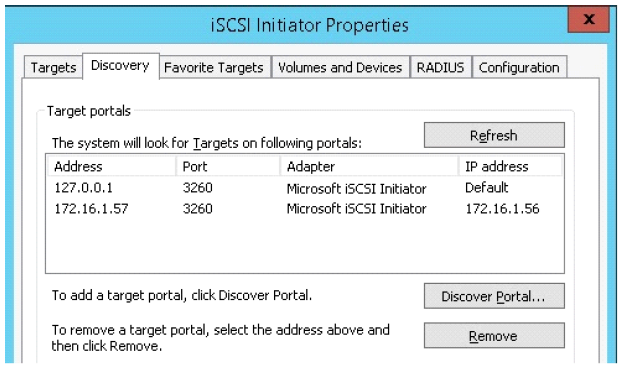
4. Complete the same steps for the second node.
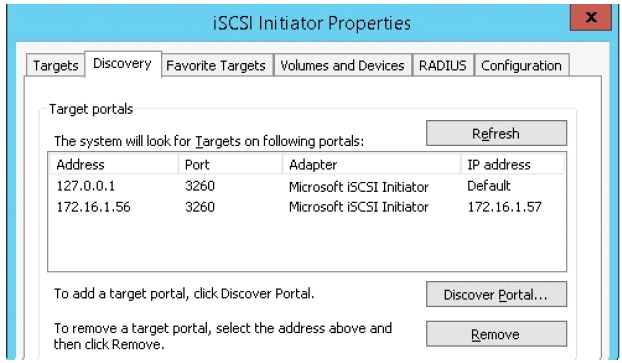
5. Click the Targets tab. The previously created targets are listed in the Discovered Targets section.
Note: If the created targets are not listed, check the firewall settings of the StarWind Server as well as the list of networks served by the StarWind Server (go to StarWind Management Console -> Configuration -> Network).
6. Select each of the targets and click Connect to add them.
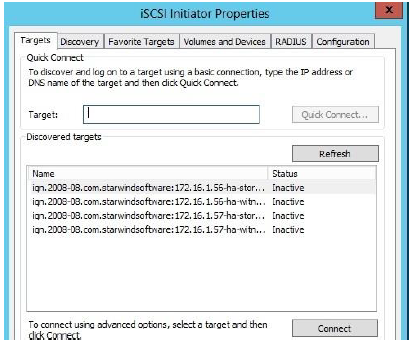
7. Select Add this connection to the list of Favorite Targets and Enable multi-path checkboxes in the Connect to Target dialog. Click Advanced.
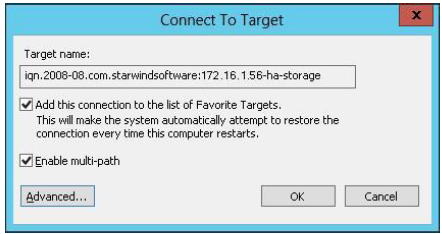
8. Select Microsoft iSCSI Initiator in the Local adapter text field.
9. In the Target portal IP select the first portal IP. Click OK.
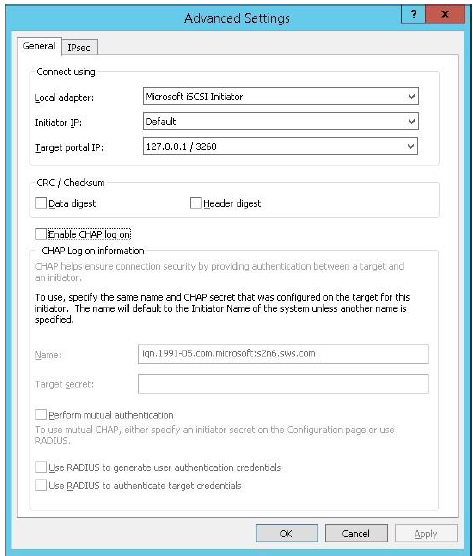
10. Select the same target and again click Connect. Perform the actions described in the items 6-7 of this section; this time specify another IP address as a target portal IP. Click OK.
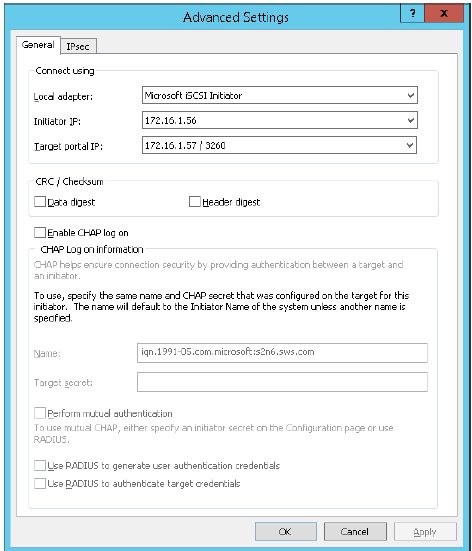
10. Repeat actions described in the steps 6-9 for each target.
11. Open the MPIO manager: Start -> Administrative Tools -> MPIO.
12. Go to the Discover Multi-Paths tab. Select the Add support for iSCSI devices checkbox and click Add.
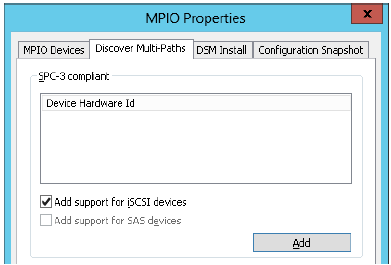
13. When prompted to restart the server, click Yes to proceed. After the server is restarted, initialize the disk and create partitions, as if it was a physical hard drive.
INITIALIZING DISKS
Note: The StarWind disks must be initialized and formatted to be used as cluster disks.
Note: Changes made to the first node (e.g. initialization or partition) are applied to the second node as soon as it is brought online.
To initialize disks and create partitions:
1. Launch the Computer Management console.
2. Go to Storage -> Disk Management.
3. Right-click each disk and select Online Disk to bring it online.
4. Right-click each disk and select Initialize Disk. Follow the wizard’s instructions to initialize disks.
Note: Select MBR (Master Boot Record) as a partition style.
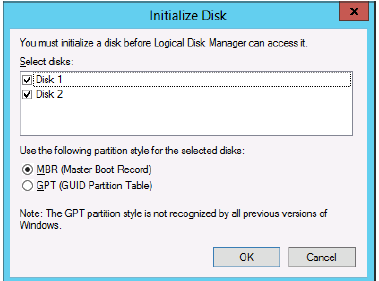
5. Click OK to continue.
The Computer Management console should look as shown on the screenshot below.
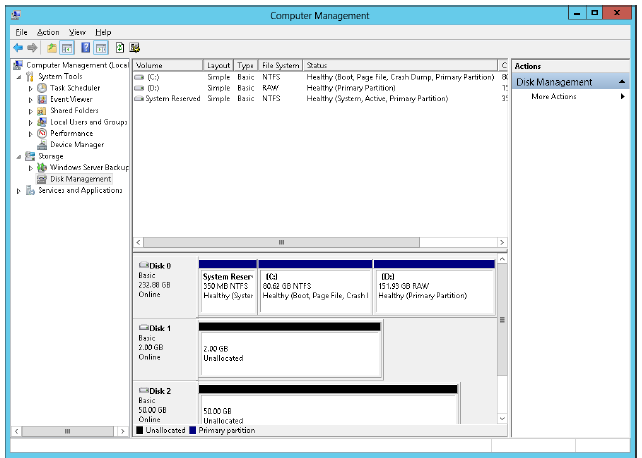
To create partitions and format new disks:
8. Right-click each disk in the Computer Management window and select New Simple Volume.
9. Follow the wizard’s instructions to create partitions.
The Computer Management window should look as shown on the screenshot below.
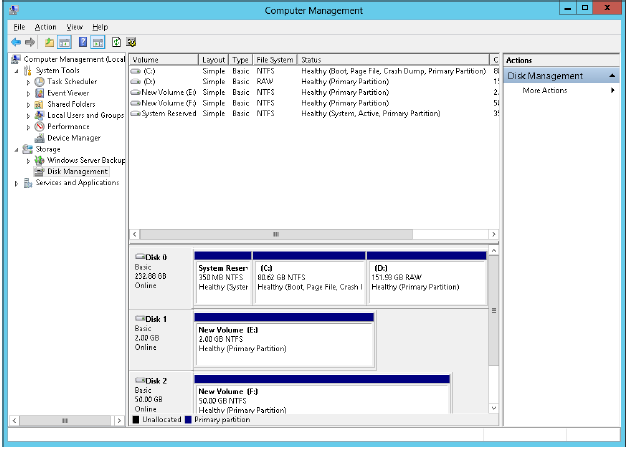
Perform the same actions on the other servers. Creation of partitions is no longer necessary. The Computer Management window should look as follows.
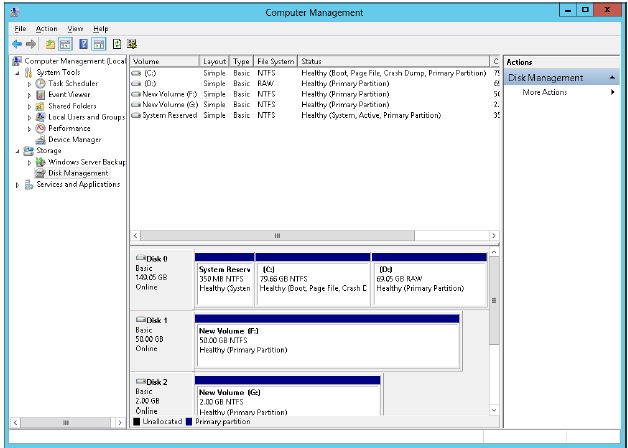
CREATING A CLUSTER
To validate a cluster:
1. Open Server Manager. Select the Failover Cluster Manager item from the Tools menu.
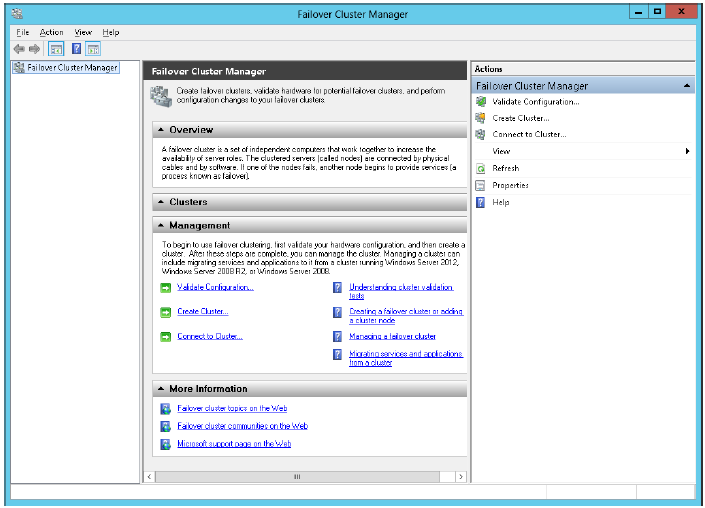
2. Before creation of cluster verify that your servers are suitable for building a cluster: click Validate a Configuration in the Actions section.
To create a cluster:
1. Click the Create a Cluster item in the Actions section of Failover Cluster Manager.
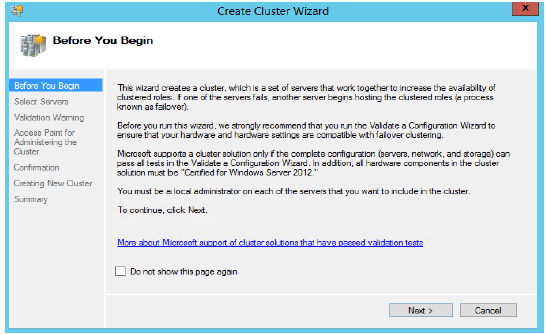
2. Specify servers to be included to the cluster.
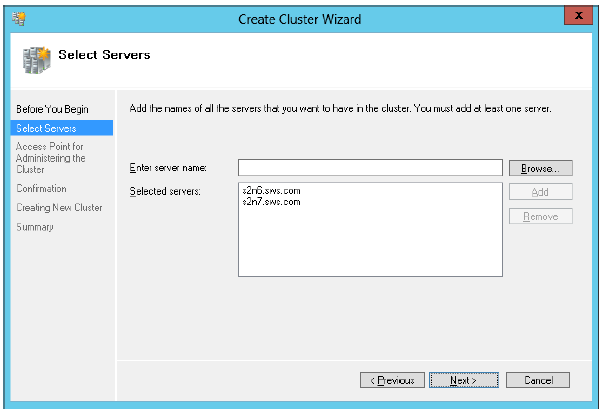
3. Click Next to continue.
4. Specify a cluster name.
Note: If the cluster servers get IP addresses over DHCP, the cluster also gets its IP address over DHCP. If the IP addresses are set statically, you need to set a cluster IP address manually as well.
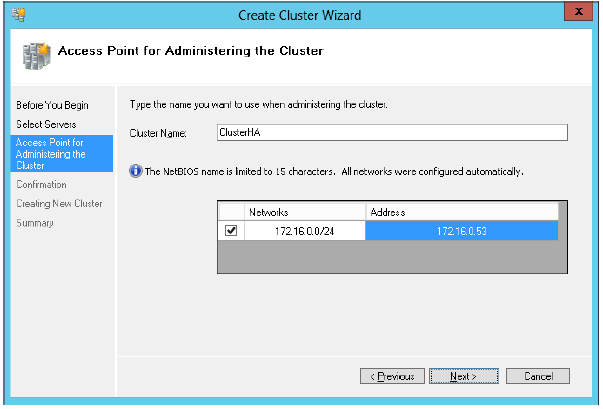
5. Click Next to continue.
6. Make sure that all of the settings are correct. Click Previous to make any changes. Click Next to continue.
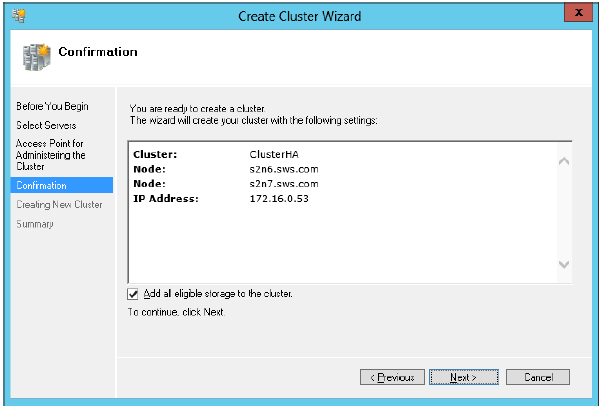
7. The process of cluster creation starts. After it is completed, the system displays a report with detailed information.
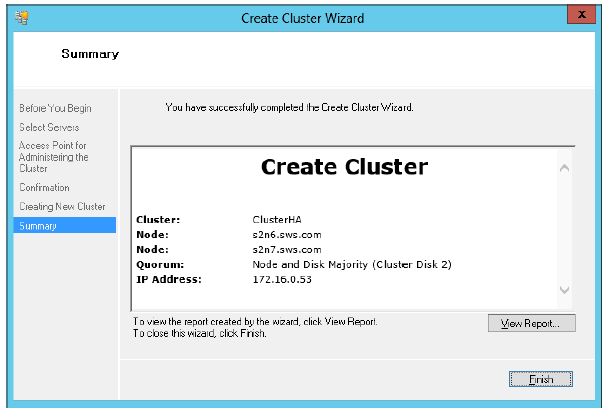
8. Click Finish to close the wizard.
After these actions, the Failover Cluster Manager window should look as follows.
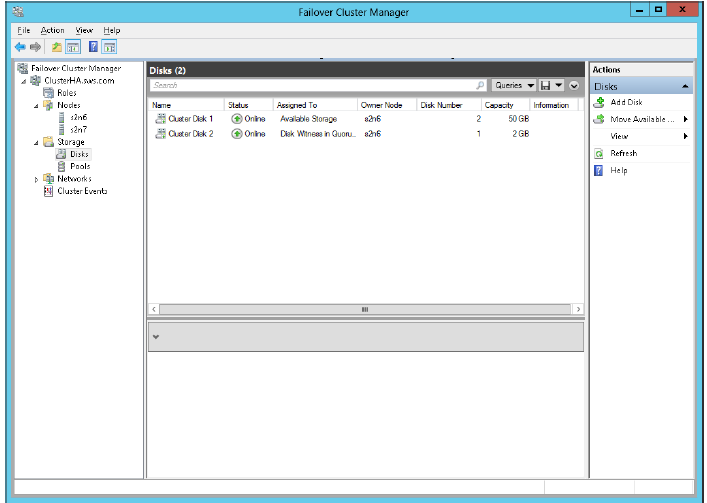
ENABLING CLUSTER SHARED VOLUMES
To enable Cluster Shared Volumes (CSV) that is necessary to work with Hyper-V virtual machines:
1. Open Failover Cluster Manager.
2. Go to Cluster->Storage -> Disks.
3. Right-click the required disk and select Add to Cluster Shared Volumes.
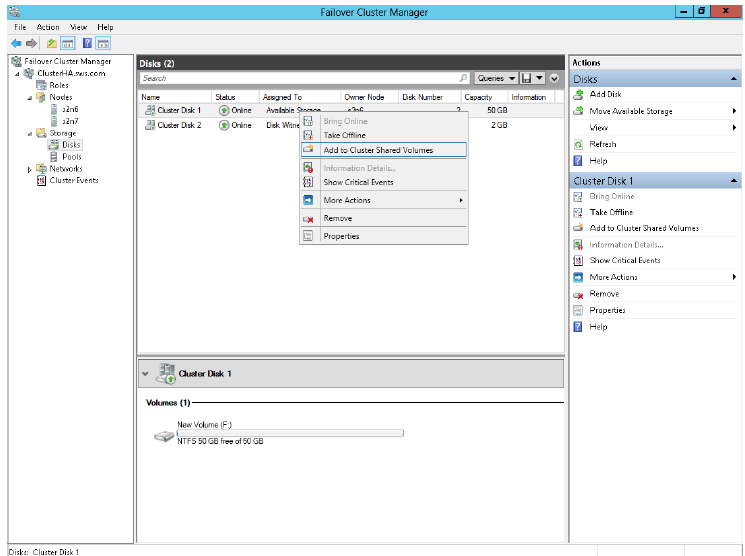
CREATING HA VIRTUAL MACHINE
To create HA virtual machine:
1. Launch Failover Cluster Manager.
2. Right-click the Roles item and go to Virtual Machines -> New Virtual Machine.
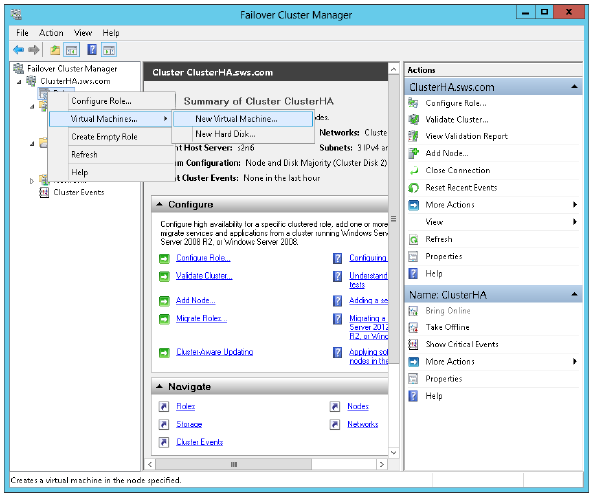
3. Select a target cluster node where a new VM will be created, and click OK.
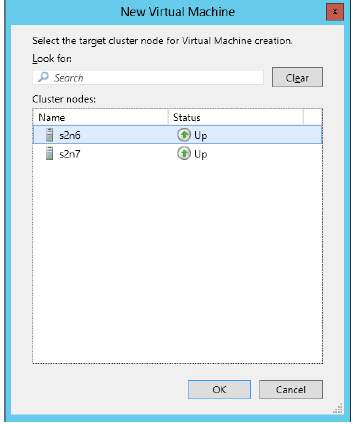
4. Specify a name and location of the virtual machine.
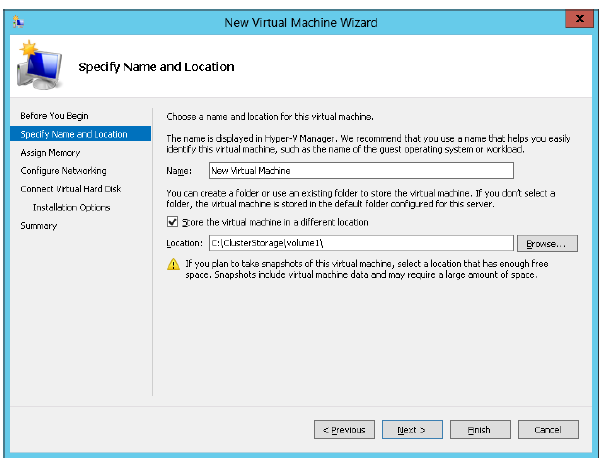
5. Click Next to continue.
6. Define memory size to allocate to the virtual machine.
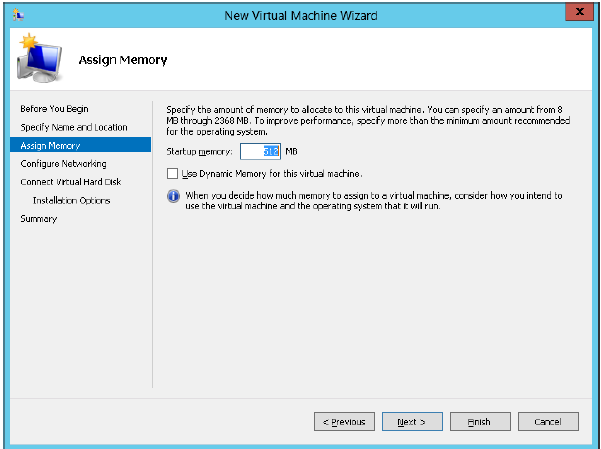
7. Click Next to continue.
8. Specify necessary network connection options or leave the default parameters unchanged.
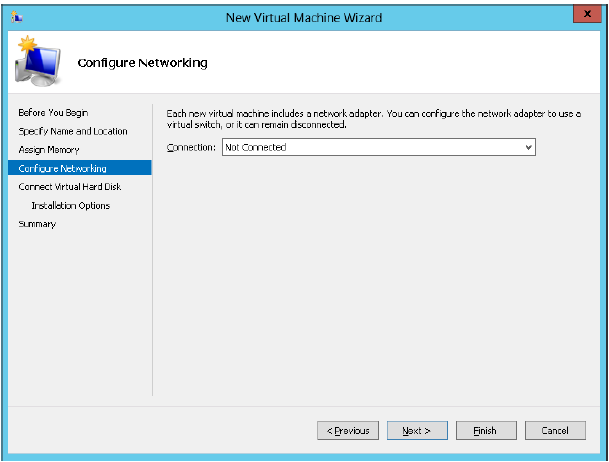
9. Click Next to continue.
10. Specify name, size, and location of the virtual disk.
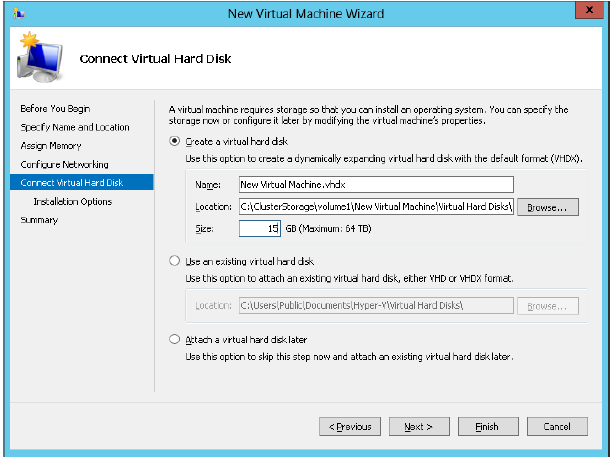
11. Click Next to continue.
12. Specify the installation options of the operating system or leave the default parameters unchanged.
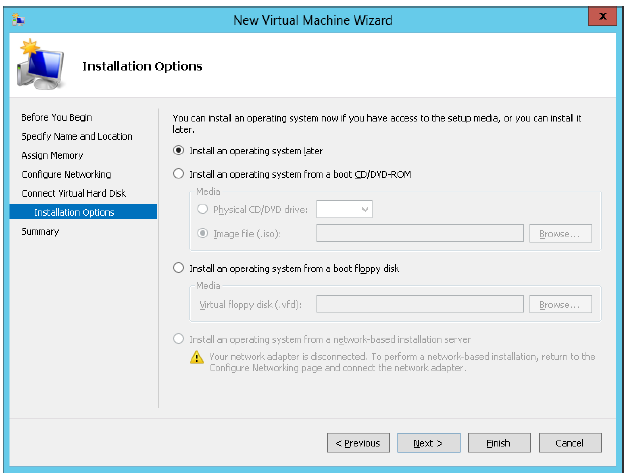
13. Click Next to continue.
14. Make sure that all parameters have been specified correctly. Click Previous to make any changes.
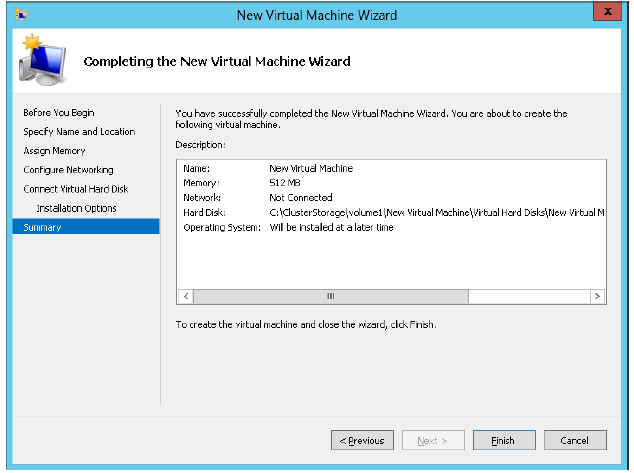
15. Click Finish.
16. Right-click the added virtual machine and click Start.
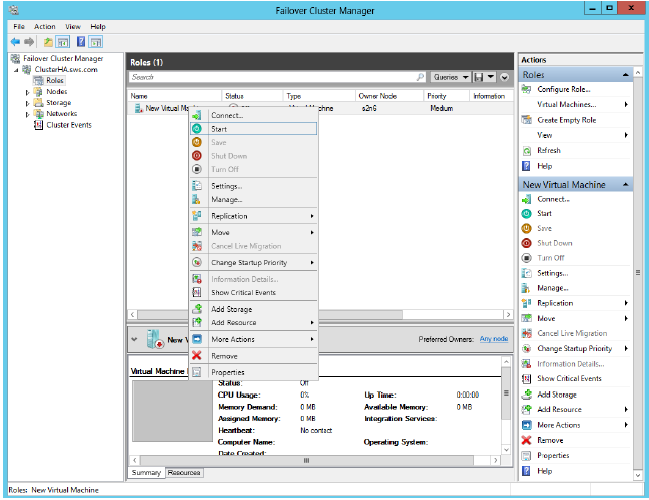
17. Make sure that the virtual machine is running and operating properly.
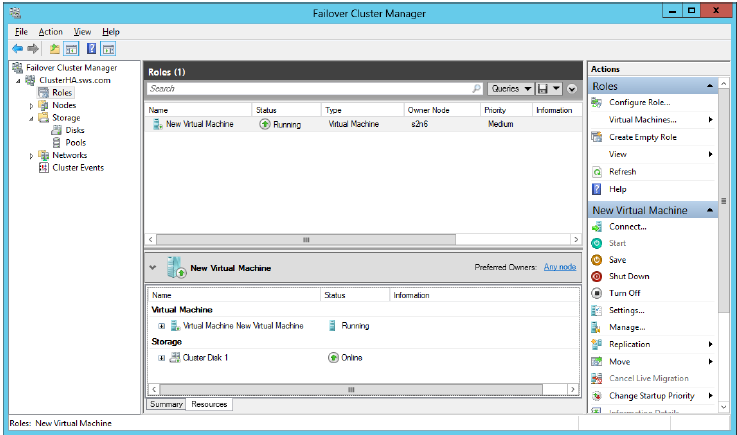
LIVE MIGRATION OF A VIRTUAL MACHINE
To perform live migration of a virtual machine to another node:
1. Launch Failover Cluster Manager.
2. Right-click the needed virtual machine and go to Move -> Live Migration -> Select Node.
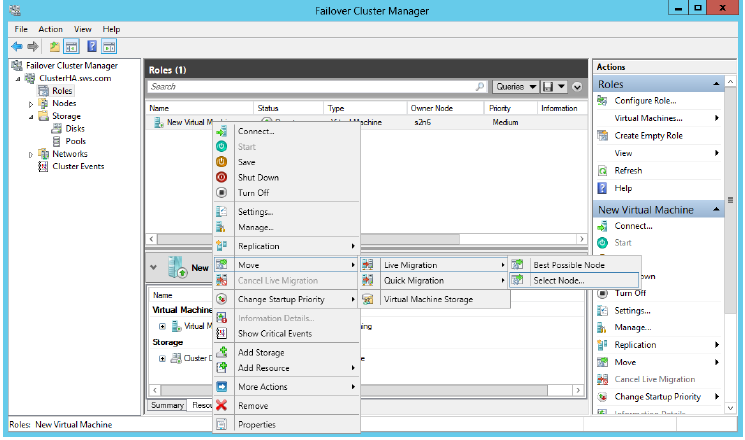
10. Select the node for live migration in the Move Virtual Machine dialog.
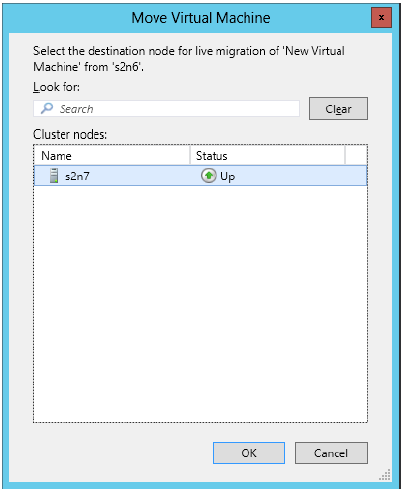
11. Click OK to continue.
Make sure that the live migration process was finished successfully. Failover Cluster Manager should look as follows.
